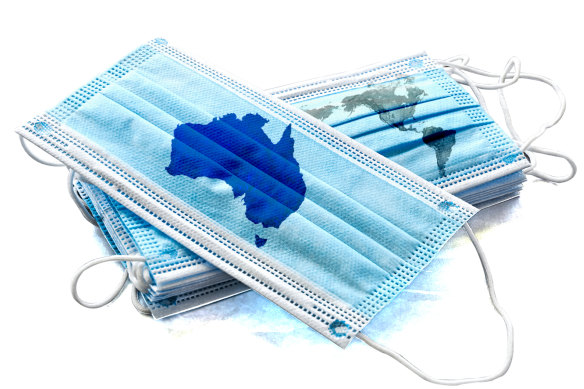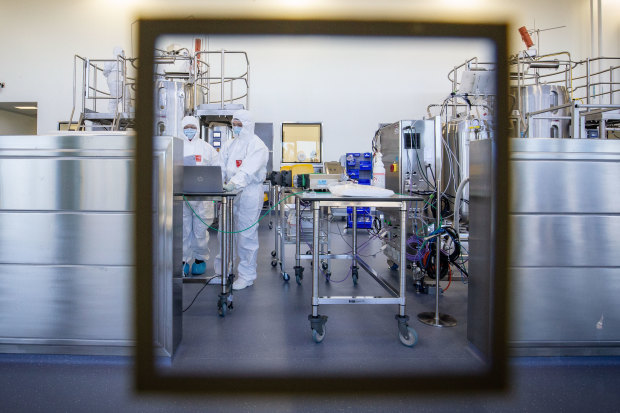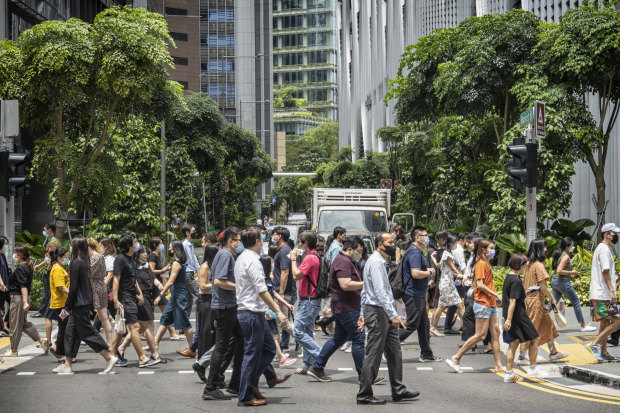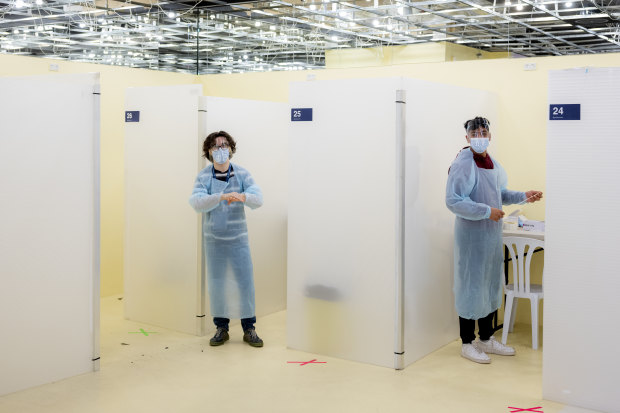Explainer
- Explainer
- Coronavirus pandemic
How does Australia’s pandemic response stack up globally?
How does Australia’s pandemic response so far compare with other countries? And who gets to take credit?
Escapees from quarantine on the lam. Angry crowds shouting against mask mandates. And states at war over border closures. These are not only scenes from the current pandemic (scenes we’d probably already like to forget) but from the last one more than a century ago.
COVID-19 has played out along familiar lines in Australia. As an island continent, we managed to hold off on much of the devastation felt elsewhere around the world for some time, just as we did when Spanish flu emerged in 1918. That means Australia has often been lauded among the top-performing countries battling COVID, with a comparatively low caseload and death rate.
But as the flu did in 1919, the coronavirus has now taken hold in the Australian community, and that’s put Australia close to the top of world caseload tallies. At times this year, we’ve been recording more new daily cases than the world’s COVID hotspot, the United States. Prime Minister Scott Morrison has admitted that he never should have said the vaccine rollout wasn’t a race, but insists that lengthy delays with the program were only a few weeks behind government targets.
So, has our pandemic response been as “world-leading” as the government claims? How do we stack up against other similar countries? And what have we learnt along the way?

Credit: Monique Westermann/Getty Images
Can you really compare countries?
Yes and no, says the Lowy Institute’s director of research Hervé Lemahieu, who tracked and ranked more than 100 country responses during the first year of the pandemic. (New Zealand came out on top back then, and Australia sat at number eight in the world.)
No single set of numbers is a fair measure in a pandemic that has evolved so quickly, demanding different responses at different moments from countries with different contexts (and luck). Do you stop at hospitalisation and mortality rates or consider who managed the economic and social fallout best too? Do you give more weight to testing rates, our main window into how the virus has taken hold in a country, or vaccination, now our main defence against it?
“There’s no magic recipe,” says Lemahieu. “It was a perfect storm. It was about learning at speed, being flexible and communicating well. This might not be a popular opinion, but politicians the world over do deserve some credit for adapting on the fly.”
Indeed, what worked before vaccines (and more infectious variants of the virus Delta and Omicron) often won’t work now. China’s then-unprecedented decision to lock down more than 10 million people in Wuhan in January 2020 may have largely stamped out the virus where it first emerged (as a fast national lockdown did soon after for New Zealand). But China’s dogged pursuit of such an elimination strategy in 2022, with cases soaring, and Omicron on the loose, is sending whole cities into crisis as people are sealed inside their homes or dragged to crowded quarantine centres. (In recent days, the World Health Organisation has urged Beijing to abandon the strategy.)
Of course, back in 2020 when Lowy calculated its index, caseloads were still the main metric, Lemahieu says. Wealthy and poor countries had found themselves on a fairly level playing field at the start of the pandemic – the virus had overwhelmed even the healthcare systems of the developed world as it carved a path out of China through Europe and the main arteries of globalisation such as New York and London.
Nations sharing a border with hotspots fared worse, those with smaller, spread-out populations, particularly island states (such as Australia), had an advantage. The developed world had better systems and resources, but also older populations more vulnerable to the virus. Poorer countries with people living in squalid or remote places faced the usual healthcare headaches but many, including across Africa, also had “more muscle memory” and experience handling deadly outbreaks such as HIV and Ebola, says epidemiologist Professor Mike Toole of the Burnet Institute, who has worked with the WHO and America’s Centre for Diseases Control and Prevention to manage outbreaks all over the world.
“COVID is still something of an epidemiological mystery in how it’s hit some countries harder than others,” says health economist Associate Professor Joseph Dieleman at the University of Washington. When he teamed up with epidemiologists to examine the responses and preparedness of more than 170 nations, no advantage stood out as making a big difference to how their first 20 months of the pandemic unfolded (including population density and GDP) save one: trust. Not just in government – our officials and institutions – but in each other. In fact, Dieleman and the team estimate that there would have been about 13 per cent fewer infections globally if every nation’s population had at least as much trust in their government as Denmark’s did (Denmark being one of the high scorers on trust).
“Trust in our [fellow citizens] actually played the biggest role, though,” Dieleman says. “It creates a kind of positive peer pressure if we trust other people are doing the right thing, getting vaccinated, following social distancing, we’re more likely to as well.”

Staff at CSL in Melbourne as they prepared to start making the AstraZeneca vaccine in November 2020.Credit: Getty Images
How did Australia react to the pandemic early on?
Australia was one of the first major countries to take the virus seriously, says Dr Margaret Harris at the WHO. “Everyone was caught unprepared”, she says. The old pandemic plans were written for influenza, and COVID (the first coronavirus to morph into a pandemic) is a different beast altogether. “When I think of that two-month window between the end of January and the end of March [2020] where we warned the world they had to act, so many didn’t,” Harris says. “Not until we used the word pandemic.”
But Australia, along with countries such as the US and Taiwan, did move quickly to shut its borders to China and impose quarantine for travellers. That border soon hardened to the rest of the world too, and a brief national lockdown kept people at home before the states began to run their own shows.
While presidents such as Donald Trump in the United States and Jair Bolsonaro in Brazil were railing against mask mandates and trumpeting dubious COVID cures to their people, our state and federal governments were (for the most part) listening to scientists. An expert advisory panel was set up as well as a wartime-style national cabinet of the Prime Minister and state and territory leaders to co-ordinate the response.
“We’re an island, we’re a country politically obsessed with border security, so it was fairly easy for us to pull up the drawbridge,” says Lemahieu. And, like many of our Asian neighbours who also handled the pandemic well early on, Australia had a fairly compliant (and trusting) population too, with a culture of following rules, he says, “unlike, say, the US and even the UK who we normally compare ourselves to”. “I know policymakers looked to Singapore, in particular, as a comparison for Australia, and a kind of model,” he says.
But if Lemahieu was ranking pandemic responses today, it is Singapore and not Australia, that would be at the top, along with Taiwan, Iceland, Denmark and Rwanda, who have all managed to keep the ship fairly steady through the COVID storm so far.

Singapore, seen here in April 2022, has been flexible with its reopening rules to keep a lid on cases.Credit: Getty Images
How have we done on some key metrics then?
The Spanish flu took about 15,000 Australian lives in less than a year. More than two years into the COVID pandemic, the coronavirus has claimed less than half of that at 7367 lives lost as of May 4, making Australia’s death rate comparatively low worldwide.
In an election pitch to voters in April, Prime Minister Scott Morrison took credit for saving the lives of 40,000 Australians from COVID (a number he has previously said is based on the average number of deaths from the virus in the OECD). Other researchers have more precisely calculated a figure of about 18,000 lives saved through interventions. “That’s still a real success,” says Dr Stephen Duckett, a former Commonwealth Health Department secretary now at the University of Melbourne. “But who gets to take credit? Apart from the [international border], the heavy lifting was really done by the states.”
If anything, Duckett argues, federal leaders often publicly undermined their state counterparts, particularly Labor governments in Victoria, Queensland and West Australia pursuing hard, fast lockdowns or border closures that worked to contain early variants of the virus. And, despite devastating leaks in hotel quarantine and tens of thousands of Australians stranded overseas, the Commonwealth was also slow to help states set up purpose-built facilities.
Meanwhile, under the federal government’s national reopening plan, our death rate is now climbing, Toole warns. “We haven’t had the hospitals as overwhelmed here, the mass graves we saw in New York or India, but it’s still more than your average 737 [plane] crashing every week. It’s still a huge strain.”
Most of the deaths have happened this year – in the wake of our “Omicron summer”, when new cases climbed as high as 100,000 a day. Our total caseload now ranks among the top 20 in the world, Toole notes, after spending the first two years down “around spot 100 on that tally”.
Another key metric has swung in the right direction, though. After starting our vaccine rollout months behind countries such as the US, the UK and Israel (“the strollout as it was called”, Duckett sighs), Australia now boasts one of the highest double-dose vaccination rates in the world among adults.
That’s helped reduce the toll of Omicron, Toole says, but the take-up of the third dose booster shots we know are essential against that more vaccine-resistant variant has not been nearly as impressive. Among children, vaccination rates are also too low, Toole says, (about 37 per cent of those aged between 5 and 11 were vaccinated as of May 4), though the safety of the shot in children has been well demonstrated by now with millions vaccinated worldwide.
On the economic front, the Morrison government also took radical action: spending billions of dollars on temporary pandemic welfare measures and business support to keep people going during lockdowns. Of course, it was later revealed some of that money was spent on companies that didn’t need it, while for many people who did, support was cut off too early.
Still, in September last year, the OECD found Australia’s economy had weathered the COVID storm better than most developed countries. (The problem, the agency warned, was that Australia’s social safety net was below OECD standards to begin with. And, as Labor has pointed out, much of the government’s debt was there before the pandemic.)
But what about those vaccine delays?
In 2020, despite pleas from the WHO that vaccines needed to be rolled out to the most vulnerable people first – in the developing world as well as the wealthy West – Australia joined other rich nations in ordering many times more vaccine than was needed for our populations.
But, in Australia it was the question of which vaccines the government ordered – a much narrower portfolio than most other countries, Duckett says – that would come to dominate the first leg of our rollout.
Australia hedged its bets on two vaccines, largely for reasons of nationalism, says Duckett – the “molecular clamp” shot in development at the University of Queensland (“It was Australian-made, after all”) and Oxford’s AstraZeneca vaccine, which could be manufactured locally through AstraZeneca’s partnership with CSL. Those decisions made sense at the time, Duckett says. “It wasn’t the government’s fault the UQ vaccine fell over [after a problem with its clinical trial data].”
But what didn’t make sense, he says, was not to procure more of the promising mRNA vaccines by Pfizer or Moderna from the start – just in case. Pfizer, had, after all, approached Australia about an early deal back in June 2020, but we didn’t order any of its vaccine until November that year, well behind many other countries.
That meant, when rare blood clotting cases were linked to AstraZeneca’s shot, there wasn’t nearly enough Pfizer in Australia to cover the age groups (under 50s) more at risk from the complication. For months, even many frontline workers struggled to get a vaccine.
Meanwhile, vaccinations in the two priority groups especially vulnerable to the virus – the aged care and disability sectors – were already months behind schedule. By the end of March, Australia had delivered just 600,000 doses – 3.4 million short of its initial target of 4 million, and it would go on to miss many revised targets thereafter. By July, shadow minister for government services Bill Shorten labelled the entire rollout “a shit show”.
Toole recalls questioning then why Australia was relying on GPs and pharmacies to distribute the vaccine – with no early plans to reach at-risk and disadvantaged demographics. Duckett has similar memories of the “logistical nightmare”.
“If you want mass vaccination, you need mass vaccination hubs,” he says. “Eventually, the states had to step in there too and get that happening.”
Still, although Australia lost critical months (when the virus was more virulent), the Commonwealth did manage to secure more supplies of Pfizer and Moderna – and the rollout accelerated remarkably, overtaking many early success stories such as the UK and the US. China, by contrast, is notable for its refusal to import mRNA vaccines widely, even in the face of mounting evidence that its own shots are not effective enough against the virus. “They’ve really dug their heels in,” says Toole.
While Lemahieu agrees that Australia clearly “bet on the wrong horses” when it came to vaccine procurement, he says it’s hard to argue we deserved to be at the front of the queue: “There were countries then who needed the vaccines before us, even Europe and the US had much more virus than we did then.”
That changed when the more contagious Delta variant took hold in Australia, he says – and our hard border began to crumble.
Yes, what about “Fortress Australia”?
Our COVID border raised eyebrows on the world stage not only for locking foreigners out but locking Australians in (except for what the government deemed essential travel) as quarantine spots ran low. During the height of India’s devastating second wave, it was even briefly illegal for Australian citizens stranded there to return home – and a small number died trying to get out of India during that three-week ban. “Apart from, say, North Korea, this wasn’t really heard of,” Lemahieu says.
Still, experts agree the hard border worked early on to keep cases low in Australia. Even at the WHO, which criticised countries with outright travel bans, Harris concedes that the evidence suggests “closing very early does protect you for a while”. “Australia did well, but it’s not a hard and fast science.”
Singapore, by contrast, took an “ambitious middle approach” to their border, Lemahieu says, reopening faster than Australia but with strict controls, as one of the first countries to vet travellers via testing and proof of vaccination.
Australia has now reopened its border, even abandoning testing before travel. “It’s bizarre how Australia sort of leapfrogged Singapore in that regard,” Lemahieu says. “We held on to our border closures for far longer, and I think we were far too stringent, but then I don’t think any country has done such a U-turn so fast either, from zero tolerance to COVID, to, in very quick order, reopening borders, even abandoning our tracing apps that are still the gold standard [in some] other countries.”
While Lemahieu says flexibility is crucial – “imagine if we were still trying for COVID zero like China” – he considers it “strange that there was no middle ground, we went from one extreme to the other”. He adds: “There’s a kind of COVID winner’s curse, where countries that did very well in the early stages of pandemic think they’ve found the winning formula, and don’t experiment with different policy settings. Well, we’re in danger of the same now, but with this reversal.”
Toole agrees that while “most of Australia” managed the pandemic well for the first two years of the pandemic, “we’ve gone too far the other way now”. “No country has been consistently good,” he says. Many of the countries that did well to contain caseloads early, such as South Korea, Vietnam and China, have since suffered huge outbreaks. “Even Israel I’d rank poorly, they’ve been great on vaccines and not much else. But Australia has really tumbled since Christmas.”
That was when Omicron broke loose – and, as it did in many countries, it overwhelmed Australia’s once high-performing testing regime. But experts say our slow adoption of at-home rapid tests was also to blame. “And they still aren’t free like they are in the US and, for a long time, the UK,” says Toole. “I don’t know how many family Christmases were ruined because of this.”
Harris speaks of a worrying decline in testing and genomic surveillance worldwide since Omicron emerged. Without that, she says, “we’re flying blind to the variants” that may yet emerge.

A COVID quick testing centre at a shopping mall in Copenhagen in January. Denmark has stood out for its high testing regime.Credit: Getty Images
What has the world learned about handling pandemics?
You can still find the Perspex screens in most countries, including Australia –leftover ghosts from our “very poor decisions” early in the pandemic, Duckett says. “Back when people were still denying COVID was airborne and saying these droplet screens would protect us. It was public health theatre.”
Now we know better – mostly, he says. He lists measures that have been shown to work – “masks, ventilation and density caps” – but adds governments are still failing to invest in long-term changes, improving ventilation in public spaces and beefing up quarantine facilities to prepare not just for more COVID oubreaks but for future pandemics as well. “Only Victoria has really done this in Australia,” adds Toole, after breaches in its hotel quarantine system led to the state’s deadly second wave. “They’ve installed 50,000 air filters in schools and I suspect that’s why we are seeing less caseload, particularly among younger people, than NSW.”
During the 19th-century cholera outbreak in London, when doctor John Snow discovered the source of the disease was contaminated water, “countries everywhere invested in proper sanitation”, Toole says. “We need to do that with respiratory viruses too.” (The federal government is now looking to copy Victoria’s school filter rollout).
Harris agrees: “Before COVID, the world didn’t believe that a virus could do what this one has done. SARS in Hong Kong was a warning that we didn’t take seriously enough.”
Disastrous riots during those past cholera outbreaks show the importance of communication too, adds Dieleman. At the WHO, Harris admits even the agency itself could have been clearer and less declarative early on (about the question of whether COVID was airborne, for example) when the science was still crystallising. “You need to be honest about what you don’t know, or you’ll be wrong and you’ll lose trust,” she says. “Meanwhile, with masks, because we had this desperate shortage around the world and healthcare workers were being decimated, we [and other health authorities] told people to hold off buying masks but that came across as people don’t need masks.”
In Australia, she says the fast-evolving science of COVID was transparent and openly debated. It was Australian experts who helped study many of the risk factors emerging from the AstraZeneca vaccine, for example. That was important (although the risk was still low), and Australia was in a better position to examine it than the UK, which, Lemahieu says, “had pushed through its rollout because they were overwhelmed [by COVID].” Unfortunately, Australia’s “high debate” as Harris calls it, fuelled confusion too. Many with very low risk of clotting complications (older populations) swore off AstraZeneca anyway.
Vaccine equity is another lesson the world should have learnt before COVID, Harris says, after the widespread hoarding of antivirals during past swine flu and HIV pandemics. Leaving the developing world unvaccinated leaves the virus more space to mutate. “The last two variants have come from countries with relatively low vaccination rates – South Africa [likely Omicron] and India [Delta],” says Toole. “And [a major variant] emerges roughly every six months, so we’re overdue.”
Since overcoming its early vaccine crunch, Harris says Australia has become a “key player and good neighbour” in helping distribute vaccines to the Pacific. Lemahieu says that also comes down to our surplus AstraZeneca – and geopolitics.
And, as the virus has swept the world, a “COVID culture war” has been raging too, he says. “Between the extremes, between ‘this is the end of the world, let’s lock down’ and the ‘let it rip’ camp, this false dichotomy between the economy and lives when … it turns out that countries that acted on the health advice also managed to mitigate the worst of the economic costs because a healthy population is one that will rebound faster economically as well.”
For Lemahieu, Australia still sits above average in its pandemic response “though not necessarily in the top league”. He says the federal government has largely “devolved responsibility to the states” where it “could have had real vision and ambition”. “We’ve done very well in terms of the immediate knee-jerk response. But then we swung from, basically, maximum fear and draconian measures to opening all the way up. And the question is: have we preserved any of that muscle memory? It’s too soon to tell.”
In the chaos of a pandemic, Duckett says we can’t judge governments with the superiority of hindsight, only by the information they had at the time. “But we still need to learn from our mistakes. And if we keep saying, ‘We’re the best in the world’, we won’t learn.”
Let us explain
If you'd like some expert background on an issue or a news event, drop us a line at explainers@smh.com.au or explainers@theage.com.au. Read more explainers here.